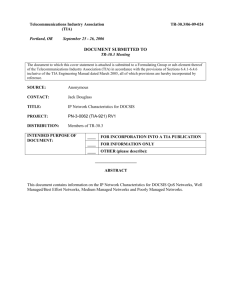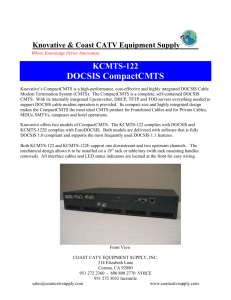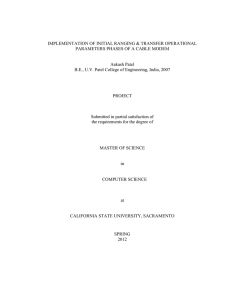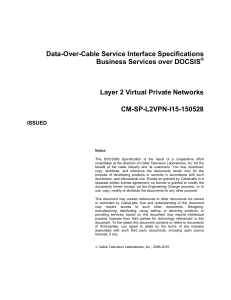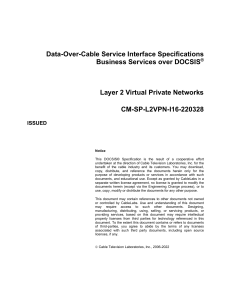cable network and multimedia services
advertisement
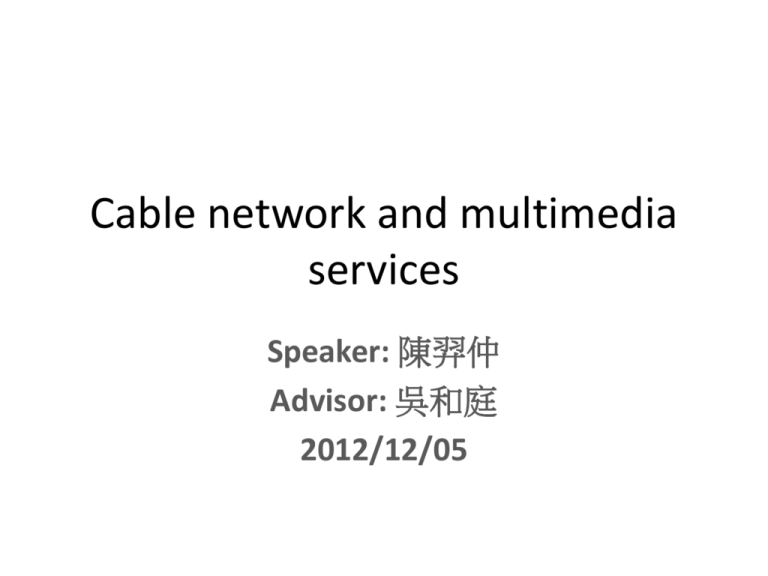
Cable network and multimedia services Speaker: 陳羿仲 Advisor: 吳和庭 2012/12/05 Introduction • Background • Cable TV Network started as cable television systems, but it has been moved to the business of Internet access Introduction Introduction 4 Introduction DOCSIS®(Data-Over-Cable Service Interface Specifications) • Developed by Cable Television Laboratories (CableLabs) • Includes contributions by operators and vendors from North America, Europe, and other regions Introduction The key functional characteristics assumed in this system are the following: • Two-way transmission. • A maximum optical/electrical spacing between the CMTS and the most distant CM of 100 miles in each direction CMTS CMTS is a DOCSIS network element that forwards packets between one or more Network Side Integrated CMTS Implements a single OSSI entity (SNMP agent, IPDR exporter) for Cable Operator configuration and management of the Downstream RF Interfaces (DRFIs) and Upstream RF Interfaces (URFIs) of the CMTS. Modular CMTS • The M-CMTS Core implements the Network Side Interfaces and the Upstream RF Interfaces of a CMTS. • The M-CMTS Core tunnels the contents of downstream DOCSIS channels across a Converged Interconnect Network (CIN) to one or more Edge QAMs (EQAMs) using the DOCSIS-standardized Downstream External Physical Interface [DEPI]. CMTS CMTS CMTS CMTS CMTS MAC Domain • DOCSIS MAC Domain is a logical subcomponent of a CMTS • Responsible for implementing all DOCSIS functions on a set of downstream channels and upstream channels. CMTS MAC Domain Downstream channel is defined as : Downstream (RF) Channel representing a single-channel downstream RF signal on a Downstream RF Port of an Integrated CMTS Downstream M-CMTS Channel representing a single-channel downstream RF signal at a remote Edge QAM that is reached via a DEPI tunnel from an M-CMTS Core. CMTS MAC Domain An upstream channel can be used to refer to either: Physical Upstream Channel defined as the DOCSIS RF signal at a single center frequency in an upstream carrier path. Logical Upstream Channel can share the center frequency of a Physical Upstream Channel, but operate in different subsets of the time domain. CMTS MAC Domain DOCSIS DOCSIS DOCSIS Service Goals • Increasing channel capacity • Enhancing network security • Expanding addressability of network elements • Deploying new service offerings DOCSIS DOCSIS 3.0 introduces a number of features • Downstream Channel Bonding with Multiple Receive Channels • Upstream Channel Bonding with Multiple Transmit Channels • IPv6 • Source-Specific Multicast • Multicast QoS DOCSIS Downstream Channel Bonding with Multiple Receive Channels: • A CM receives simultaneously on multiple receive channels. • At the MAC layer to schedule packets for a single service flow across those multiple channels. • Offers significant increases in the peak downstream data rate that can be provided to a single CM. DOCSIS Upstream Channel Bonding with Multiple Transmit Channels: • A CM that transmits simultaneously on multiple transmit channels. • Refers to the ability to schedule the traffic for a single upstream service flow across those multiple channels. • Offers significant increases in the peak upstream data rate that can be provided to a single CM. • DOCSIS 3.0 also introduces other enhancements in the upstream request-grant process that improve the efficiency of the upstream link. DOCSIS IPv6: • DOCSIS 3.0 introduces built-in support for the Internet Protocol version 6. • CMs can be provisioned with an IPv4 management address, an IPv6 management address, or both. • CMs can provide transparent IPv6 connectivity to devices behind the cable modem (CPEs), with full support for Quality of Service and filtering. DOCSIS Source-Specific Multicast: • DOCSIS 3.0 supports delivery of SourceSpecific IP Multicast streams to CPEs. • Rather than extend the IP multicast protocol awareness of cable modems to support enhanced multicast control protocols, DOCSIS 3.0 takes a different approach. All awareness of IP multicast is moved to the CMTS. DOCSIS Multicast QoS: • DOCSIS 3.0 defines a standard mechanism for configuring the Quality of Service for IP multicast sessions. • Introduces the concept of a "Group Service Flow" for multicast traffic that references a Service Class Name that defines the QoS parameters for the service flow. QoS Quality of Service related features described in this specification include: • Packet Classification and Flow Identification • Service Flow QoS Scheduling with a set of QoS Parameters, including: › › › › Traffic Priority Token Bucket Rate Shaping/Limiting Reserved (Guaranteed) Data Rate Latency and Jitter Guarantees • Both Static and Dynamic QoS Establishment • Two-Phase Activation Model for Dynamic QoS QoS Service Flow • A MAC layer transport service which provides unidirectional transport of packets from the upper layer service entity to the RF • Shapes, polices, and prioritizes traffic according to QoS traffic parameters defined for the Flow. • Have a 32-bit Service Flow Identifier (SFID) assigned by the CMTS. QoS The requirements for Quality of Service include: • • • • • • • A configuration and registration function for pre-configuring per-CM QoS Service Flows and traffic parameters. A signaling function for dynamically establishing QoS-enabled Service Flows and traffic parameters. CMTS MAC scheduling of downstream and upstream Service Flows based on QoS parameters for the Service Flow. CM and CMTS traffic-shaping, traffic-policing, and traffic-prioritization based on QoS parameters for the Service Flow. Classification of packets arriving from the upper layer service interface to a specific active Service Flow. Grouping of Service Flow properties into named Service Classes, so upper layer entities and external applications (at both the CM and CMTS) can request Service Flows with desired QoS parameters in a globally consistent way. Assignment of Service Flows to particular upstream or downstream channels that reach the CM based on elements of the QoS parameter set for the Service Flow. QoS Service Flow Scheduling Services • Scheduling services are designed to improve the efficiency of the poll/grant process. • By specifying a scheduling service and its associated QoS parameters, the CMTS can anticipate the throughput and latency needs. ACCESS CONTROL PROTOCOL 29 ACCESS CONTROL PROTOCOL ACCESS CONTROL PROTOCOL Conclusion • Increased bandwidth requirements of multimedia applications • CATV infrastructures already connect a majority of homes. • The Hybrid Fiber Coax (HFC) used in CATV networks can be used to deliver broadband services. • Qos REFERENCES • Cable Television Laboratories, Inc., “Data over cable service interface specifications MAC and upper layer protocols interface specification,” CM-SP-MULPIv3.0-I19-120809, Aug. 2012. • D. Fellows and D. Jones, “DOCSISTM Cable Modem Technology,” IEEE Communications Magazine, Vol. 39, No. 3, pp. 202-209, March 2001

